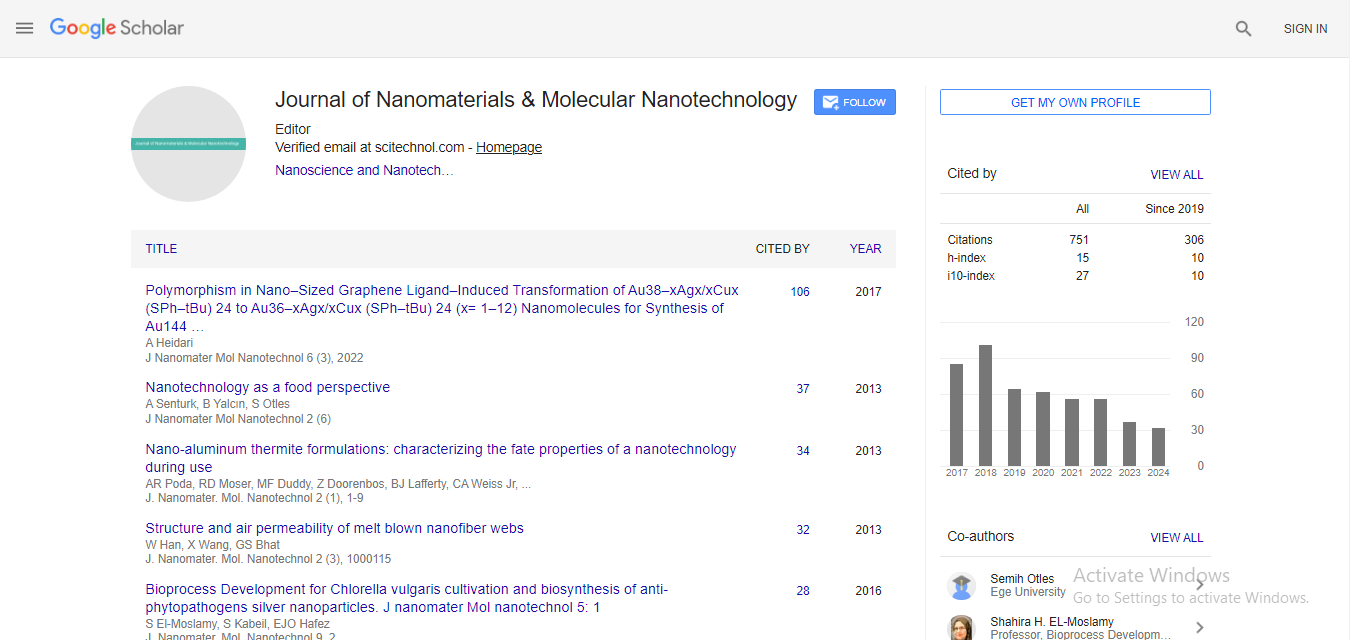Structural changes and reactions in reversibility behavior of shape memory alloy
Osman Adiguzel
Firat University, Turkey
: J Nanomater Mol Nanotechnol
Abstract
Some materials take place in class of smart materials with adaptive properties and stimulus response to the external changes. Shape memory alloys take place in this group with shape reversibility character and capacity of responding to changes in the environment. These alloys exhibit a peculiar property called shape memory effect, which is characterized by the recoverability of two certain shapes of material at different temperatures. This property is characterized by the recoverability of two certain shapes of material at different temperatures. These alloys possess two unique abilities: the capacity to recover large strains and to generate internal forces during their activation. Shape memory effect is initiated by successive cooling and deformation treatments and activated thermally on heating and cooling, with which shape of material cycles between original and deformed shapes in reversible way. Therefore, this behavior can be called Thermoelasticity. The basis of this phenomenon is the stimulus-induced phase transformations, thermal and stress induced martensitic transformations, which govern the remarkable changes in internal crystalline structure and properties of the materials. Thermal induced martensitic transformation occurs on cooling, with cooperative movement of atoms in, <110> type directions on the {110} type planes of austenite matrix, along with lattice twinning and ordered parent phase structures turn into twinned martensite structures. The twinned structures turn into detwinned structures by means of stress induced transformation by stressing the material in the martensitic condition. Martensitic transformations are diffusion less transformations and movements of atoms are confined into neighbor atom distances. Shape memory alloys exhibit another property called super elasticity. This behavior is performed in mechanical manner with stressing and releasing the material in elasticity limit at a constant temperature in parent phase region and shape recovery occurs instantly and simultaneously releasing, by exhibiting elastic material behavior. Superelasticity is performed in non-linear way; stressing and releasing paths are different in the stress-strain diagram and hysteresis loop refers to energy dissipation. The strain energy is stored after releasing and these alloys are mainly used as deformation absorbent materials in control of civil structures subjected to seismic events, due to the absorbance of strain energy during any disaster or earthquake. Copper based alloys exhibit this property in metastable β-phase region. Lattice twinning is not uniform in these alloys and cause to the formation of the complex layered structures with martensitic transformation like 3R, 9R or 18R depending on the stacking sequences on the close-packed planes of the ordered lattice. In the present contribution, x-ray diffraction and Transmission Electron Microscopy (TEM) and Differential Scanning Calorimetry (DSC) studies were carried out on copper based CuZnAl and CuAlMn alloys. X-ray diffractograms taken in a long-time interval show that locations and intensities of diffraction peaks change with the aging time at room temperature and this result refers to the rearrangement of atoms in diffusive manner. Keywords: Shape memory effect, Martensitic transformation, Thermoelasticity, Super elasticity, Twinning, Detwinning.
Biography
Adiguzel graduated from Department of Physics, Ankara University, Turkey in 1974 and received PhD degree from Dicle University, Diyarbakir-Turkey. He has studied at Surrey University, Guildford, UK, as a post-doctoral research scientist in 1986-1987 and studied were focused on shape memory effect in shape memory alloys. His academic life started following graduation by attending an assistant to Dicle University in January 1975. He became professor in 1996 at Firat University in Turkey, and retired on November 28, 2019, due to the age limit of 67, following academic life of 45 years. He supervised 5 PhD theses and 3 M.Sc. theses and published over 80 papers in international and national journals; He joined over 120 conferences and symposia in international level with contribution. He served the program chair or conference chair/cochair in some of these activities. Also, he joined in last six years (2014-2019) over 60 conferences as Keynote Speaker and Conference Co-Chair organized by different companies. Additionally, he joined over 70 online conferences in the same way in pandemic period of 2020-2021. Dr. Adiguzel served his directorate of Graduate School of Natural and Applied Sciences, Firat University, in 1999-2004. He received a certificate awarded to him and his experimental group in recognition of significant contribution of 2 patterns to the Powder Diffraction File-Release 2000. The ICDD (International Centre for Diffraction Data) also appreciates cooperation of his group and interest in Powder Diffraction File.
 Spanish
Spanish  Chinese
Chinese  Russian
Russian  German
German  French
French  Japanese
Japanese  Portuguese
Portuguese  Hindi
Hindi 



